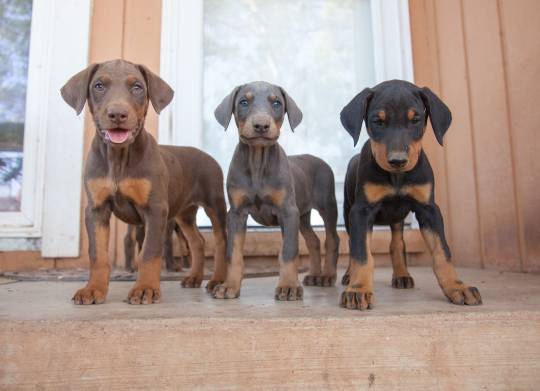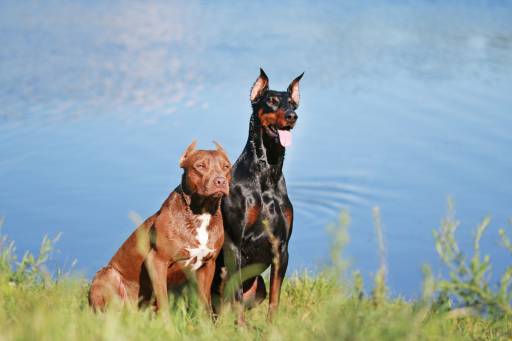Connect with a verified veterinarian in minutes. Licensed vets are available 24/7 to answer your questions. No need to worry about your furry family member.
Are you considering adopting a Doberman? If so, you’ll want to know everything about this dog breed, including the colors these dogs come in! You may be surprised at the many colors of a Doberman Pinscher!
What is a Doberman Pinscher?
The Doberman has a very interesting history. This dog breed was developed by a guy named Louis Dobermann, who lived in Germany in the 1800s. He was a tax collector, and as you can imagine, this was a dangerous line of work. There were many bandits in the area at the time who would attack anyone who had large sums of money.
So, Dobermann was determined to develop a dog breed that was very protective. He bred several different dog breeds together, resulting in the Doberman Pinscher. From that time to now, Dobermans have become a popular dog breed around the world.
These dogs have an elegant, regal appearance. They’re highly intelligent dogs that are always on the alert and extremely loyal. They make great guard dogs; however, Dobermans also make wonderful family companions.
This is a dog that loves to be part of a family. They want to be close to their pet parents and naturally protect their families. However, it’s essential that these dogs are properly trained and socialized from puppyhood. Then they make wonderful family companions and get along with other dogs. They’re even great with kids!
Different Types of Dobermans: American vs European
Did you know there are two types of Dobermans? If not, don’t feel bad. Not many people realize this. While they are the same dog breed, there are some differences between these two beautiful Doberman types:
American Dobbies were usually bred for showing, whereas European Dobermans were bred for protection work.
American Dobermans are smaller than their European counterparts and have less muscle mass. These dogs also are thinner and sleeker than their European cousins. And they have longer bodies.
American Dobbies are not working dogs; they were bred for show or as companions. They usually have a more gentle temperament than European Dobbies. They’re also more sensitive to their humans.
This is only a general overview of the differences between these two Doberman types. The main takeaway is that the American Dobbie was bred for show, while the European version has been developed to work as a watchdog. No matter what, these are beautiful dogs that can make wonderful, protective family companions.
Now, let’s move on to Doberman colors!

Review symptoms, medications & behavior to keep your pets healthy with a Vet Online in just minutes.
Ask a Vet Live NowDoberman Base Coats & Genes
Doberman Pinschers get their base coat colors for two genes. One of these genes creates a black color, while the second gene causes a dilute pigment. The result is four AKC (American Kennel Club) recognized colors for Dobermans, including:
- Black & rust
- Blue & rust
- Red & rust
- Fawn & rust
What’s interesting is that all Dobermans carry the gene for rust markings. The rust marks must have clear outlines and appear on all four paws, the muzzle, and the chest (in two clear spots—one above each leg), at the base of the tail, on the throat, and above each eye.
Let’s take a closer look at the standard colors for these dogs.
Black & Rust
Black & Rust Dobermans are standard for dogs that are two colors. The coat color develops when a Doberman’s genes express the black gene without the dilute gene.
These colors are the most popular in this breed and the most recognizable for those who don’t know much about dogs.
Blue & Rust
In the blue & rust Dobbie, their base color is a diluted black that can appear as charcoal, gray, silver, or even purple.
While these dogs are beautiful and rare, they are prone to a skin condition called alopecia. The condition causes hair thinning, hair loss, and/or dry, itchy skin.
Red & Rust
The red & rust Doberman is sometimes also called brown or chocolate, red, and rust. This color is the second most common color in Dobermans. The color is a little less common than black; however, you can easily find a dog of this color. The coat color can range from a light copper to dark chocolate, with everything in between.
Pet parents of red Dobbies say they’re usually more easygoing and have a less serious personality. They’re also said to be less territorial than other Dobermans.
Rust & Fawn
The rust & fawn Doberman has a combination of a dominant dilute gene with a recessive black gene. This produces a lighter color that’s said to be fawn or Isabella. This color is the least commonly recognized in Dobermans.
These dogs can suffer from skin issues, including ingrown hairs, staph infections, and acne. They may also develop alopecia.
Non-Standard Doberman Colors
Dobermans also come in other colors; however, these are considered to be non-standard. That means they are not recognized by the AKC or European kennel clubs.
White Doberman
White Dobbies are almost completely white, without the normal rust markings. If the dogs do have markings, these are very white.
This is a highly controversial Doberman color. The reason is that white dogs are prone to a wide range of health issues, including poor eyesight, skin cancer, and more.
It’s best to avoid breeders who are selling white Dobermans. This is not a practice that’s recommended for the reasons mentioned above.
Black Doberman
Black Dobermans sometimes produce black pigment to the point that any rust markings are not seen. In that case, the dog is entirely black. These are very rare Dobbies.
The good news is that black Dobermans don’t seem to suffer from skin issues more than other Dobbies of other colors. However, they can have some health issues, especially if the dogs have been inbred.
Albino Doberman
No one’s sure whether an albino Doberman is even possible. However, some disreputable breeders may try to sell a white Dobbie as an albino.
However, the clue is in the dog’s eyes. A true albino dog (or any other animal) will have white fur and pink eyes. This is because their bodies don’t produce any pigments.
If you see any breeder advertising an albino Doberman for sale, it’s best to completely avoid them. These are white Dobbies that are prone to a wide range of health issues.
Summing It Up
Dobermans are beautiful dogs that can make wonderful family companions. They come in a wide range of colors; however, it’s best to steer clear of white Dobbies and those in other colors that cause health issues.
No matter what color a Dobbie is (other than white), he will make an excellent family companion that brings plenty of love to everyone in the family!
Connect with a verified veterinarian in minutes. Licensed vets are available 24/7 to answer your questions. No need to worry about your furry family member.

Julie
Julie is a graduate of the University of North Carolina, Wilmington, where she studied Animal science. Though contrary to the opinion of her parents she was meant to study pharmacy, but she was in love with animals especially cats. Julie currently works in an animal research institute (NGO) in California and loves spending quality time with her little cat. She has the passion for making research about animals, how they survive, their way of life among others and publishes it. Julie is also happily married with two kids.
Review symptoms, medications & behavior to keep your pets healthy with a Vet Online in just minutes.
Ask a Vet Live Now




